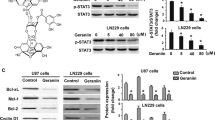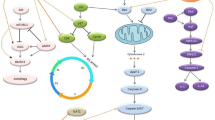Abstract
Plants of the genus Scutellaria constitute one of the common components of Eastern as well as traditional American medicine against various human diseases, including cancer. In this study, we examined the in vivo anti-glioma activity of a leaf extract of Scutellaria ocmulgee (SocL) while also exploring their potential molecular mechanisms of action. Oral administration of SocL extract delayed the growth of F98 glioma in F344 rats, both in intracranial and subcutaneous tumor models. Immunohistochemistry revealed inhibition of Akt, GSK-3α/β and NF-κB phosphorylation in the subcutaneous tumors following treatment with Scutellaria. The SocL extract as well as the constituent flavonoid wogonin also showed dose- and time-dependent inhibition of Akt, GSK-3α/β and NF-κB in F98 cell cultures in vitro, as determined by western blot analysis. Pharmacologic inhibitors of PI3K and NF-κB also significantly inhibited the in vitro proliferation of F98 glioma cells, indicating the key role of these signaling molecules in the growth of malignant gliomas. Transfection of F98 cells with constitutively active mutant of AKT (AKT/CA), however, did not significantly reverse Scutellaria-mediated inhibition of proliferation, indicating that Scutellaria flavonoids either directly inhibited Akt kinase activity or acted downstream of Akt. In vitro Akt kinase assay demonstrated that the SocL extract or wogonin could indeed bind to Akt and inhibit its kinase activity. This study provides the first in vivo evidence and mechanistic support for anti-glioma activity of Scutellaria flavonoids and has implications in potential usage of Scutellaria flavonoids in adjuvant therapy for malignant tumors, including gliomas.







Similar content being viewed by others
Abbreviations
- CA:
-
Constitutively active
- DN:
-
Dominant negative (mutant)
- GSK:
-
Glycogen synthase kinase
- NF-κB:
-
Nuclear factor-κB
- SocL:
-
Scutellaria ocmulgee leaf (extract)
References
Merchant TE, Pollack IF, Loeffler JS (2010) Brain tumors across the age spectrum: biology, therapy, and late effects. Semin Radiat Oncol 20(1):58–66
Parajuli P et al (2007) Dendritic cell-based active specific immunotherapy for malignant glioma. Expert Opin Biol Ther 7(4):439–448
Huang WH, Lee AR, Yang CH (2006) Antioxidative and anti-inflammatory activities of polyhydroxyflavonoids of Scutellaria baicalensis GEORGI. Biosci Biotechnol Biochem 70(10):2371–2380
Nijveldt RJ et al (2001) Flavonoids: a review of probable mechanisms of action and potential applications. Am J Clin Nutr 74(4):418–425
Awad R et al (2003) Phytochemical and biological analysis of skullcap (Scutellaria lateriflora L.): a medicinal plant with anxiolytic properties. Phytomedicine 10(8):640–649
Ernst E (2006) Herbal remedies for anxiety—a systematic review of controlled clinical trials. Phytomedicine 13(3):205–208
Armstrong TS, Gilbert MR (2008) Use of complementary and alternative medical therapy by patients with primary brain tumors. Curr Neurol Neurosci Rep 8(3):264–268
Chung H et al (2008) Anticancer effects of wogonin in both estrogen receptor-positive and -negative human breast cancer cell lines in vitro and in nude mice xenografts. Int J Cancer 122(4):816–822
Baumann S et al (2008) Wogonin preferentially kills malignant lymphocytes and suppresses T-cell tumor growth by inducing PLCgamma1- and Ca2+-dependent apoptosis. Blood 111(4):2354–2363
Rugo H et al (2007) Phase I trial and antitumor effects of BZL101 for patients with advanced breast cancer. Breast Cancer Res Treat 105(1):17–28
Scheck AC et al (2006) Anticancer activity of extracts derived from the mature roots of Scutellaria baicalensis on human malignant brain tumor cells. BMC Complement Altern Med 6:27
Parajuli P et al (2009) In vitro antitumor mechanisms of various Scutellaria extracts and constituent flavonoids. Planta Med 75(1):41–48
Li-Weber M (2009) New therapeutic aspects of flavones: the anticancer properties of Scutellaria and its main active constituents Wogonin, Baicalein and Baicalin. Cancer Treat Rev 35(1):57–68
Shen SC et al (2006) Lipopolysaccharide plus 12-o-tetradecanoylphorbol 13-acetate induction of migration and invasion of glioma cells in vitro and in vivo: differential inhibitory effects of flavonoids. Neuroscience 140(2):477–489
Fas SC et al (2006) Wogonin sensitizes resistant malignant cells to TNFalpha- and TRAIL-induced apoptosis. Blood 108(12):3700–3706
Chen LG et al (2008) Wogonin, a bioactive flavonoid in herbal tea, inhibits inflammatory cyclooxygenase-2 gene expression in human lung epithelial cancer cells. Mol Nutr Food Res 52(11):1349–1357
Zhang HW et al (2008) Wogonin induced differentiation and G1 phase arrest of human U-937 leukemia cells via PKCdelta phosphorylation. Eur J Pharmacol 591(1–3):7–12
Mathieu D et al (2007) Standardization and detailed characterization of the syngeneic Fischer/F98 glioma model. Can J Neurol Sci 34(3):296–306
Kim HS et al (2002) Regulation of angiogenesis by glycogen synthase kinase-3beta. J Biol Chem 277(44):41888–41896
Suhara T et al (2002) Suppression of Akt signaling induces Fas ligand expression: involvement of caspase and Jun kinase activation in Akt-mediated Fas ligand regulation. Mol Cell Biol 22(2):680–691
Mathupala SP, Parajuli P, Sloan AE (2004) Silencing of monocarboxylate transporters via small interfering ribonucleic acid inhibits glycolysis and induces cell death in malignant glioma: an in vitro study. Neurosurgery 55(6):1410–1419 (discussion 1419)
Chinni SR, Sarkar FH (2002) Akt inactivation is a key event in indole-3-carbinol-induced apoptosis in PC-3 cells. Clin Cancer Res 8(4):1228–1236
Mantel N, Haenszel W (1959) Statistical aspects of the analysis of data from retrospective studies of disease. J Natl Cancer Inst 22:719
Abd El Mohsen MM et al (2002) Uptake and metabolism of epicatechin and its access to the brain after oral ingestion. Free Radic Biol Med 33(12):1693–1702
Peng HW et al (1998) Determination of naringenin and its glucuronide conjugate in rat plasma and brain tissue by high-performance liquid chromatography. J Chromatogr B Biomed Sci Appl 714(2):369–374
Staal SP, Hartley JW, Rowe WP (1977) Isolation of transforming murine leukemia viruses from mice with a high incidence of spontaneous lymphoma. Proc Natl Acad Sci USA 74(7):3065–3067
Castellino RC, Durden DL (2007) Mechanisms of disease: the PI3K-Akt-PTEN signaling node–an intercept point for the control of angiogenesis in brain tumors. Nat Clin Pract Neurol 3(12):682–693
Cheng JQ et al (2005) The Akt/PKB pathway: molecular target for cancer drug discovery. Oncogene 24(50):7482–7492
Kubiatowski T et al (2001) Association of increased phosphatidylinositol 3-kinase signaling with increased invasiveness and gelatinase activity in malignant gliomas. J Neurosurg 95(3):480–488
Hennessy BT et al (2005) Exploiting the PI3K/AKT pathway for cancer drug discovery. Nat Rev Drug Discov 4(12):988–1004
Korur S et al (2009) GSK3beta regulates differentiation and growth arrest in glioblastoma. PLoS One 4(10):e7443
Miyashita K et al (2009) Potential therapeutic effect of glycogen synthase kinase 3beta inhibition against human glioblastoma. Clin Cancer Res 15(3):887–897
Kotliarova S et al (2008) Glycogen synthase kinase-3 inhibition induces glioma cell death through c-MYC, nuclear factor-kappaB, and glucose regulation. Cancer Res 68(16):6643–6651
Ozes ON et al (1999) NF-kappaB activation by tumour necrosis factor requires the Akt serine-threonine kinase. Nature 401(6748):82–85
Romashkova JA, Makarov SS (1999) NF-kappaB is a target of AKT in anti-apoptotic PDGF signalling. Nature 401(6748):86–90
Acknowledgements
We acknowledge research grant from the Fund for Medical Research and Education (FMRE), to PP and the USDA-CSREES Research Project # 2008-02492 (Award # 2008-38814-04737) to NJ (PD), PP and AKY (Co-PD’s). We are grateful to Dr. Kenneth Walsh, University of Boston, MA for kindly providing us with the AKT plasmid constructs. We thank Chao (Becky) Wong for technical assistance; Dr. Yimin Shen for help with MRI imaging; and Brandon Parker for manuscript editing.
Author information
Authors and Affiliations
Corresponding author
Rights and permissions
About this article
Cite this article
Parajuli, P., Joshee, N., Chinni, S.R. et al. Delayed growth of glioma by Scutellaria flavonoids involve inhibition of Akt, GSK-3 and NF-κB signaling. J Neurooncol 101, 15–24 (2011). https://doi.org/10.1007/s11060-010-0221-x
Received:
Accepted:
Published:
Issue Date:
DOI: https://doi.org/10.1007/s11060-010-0221-x




